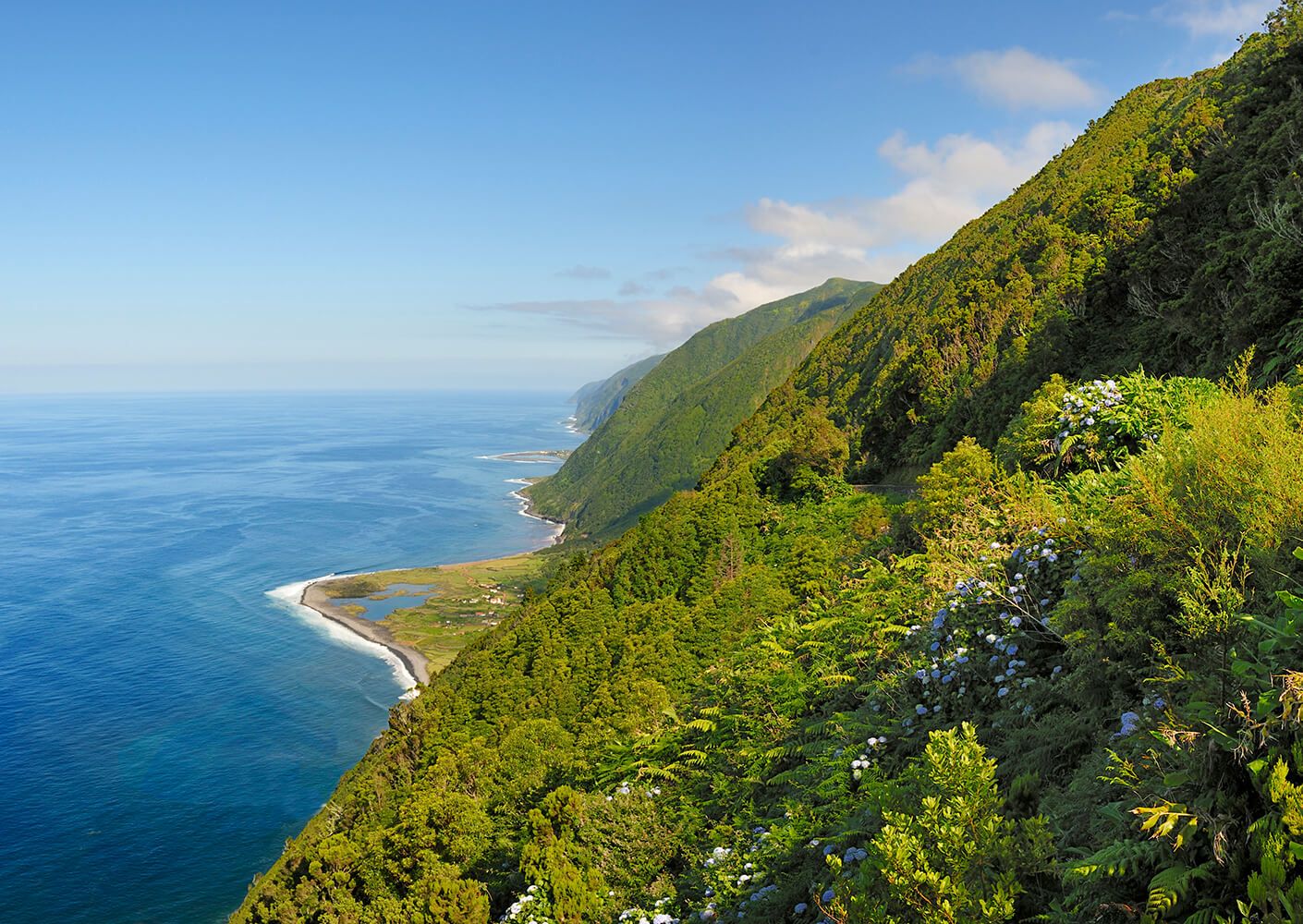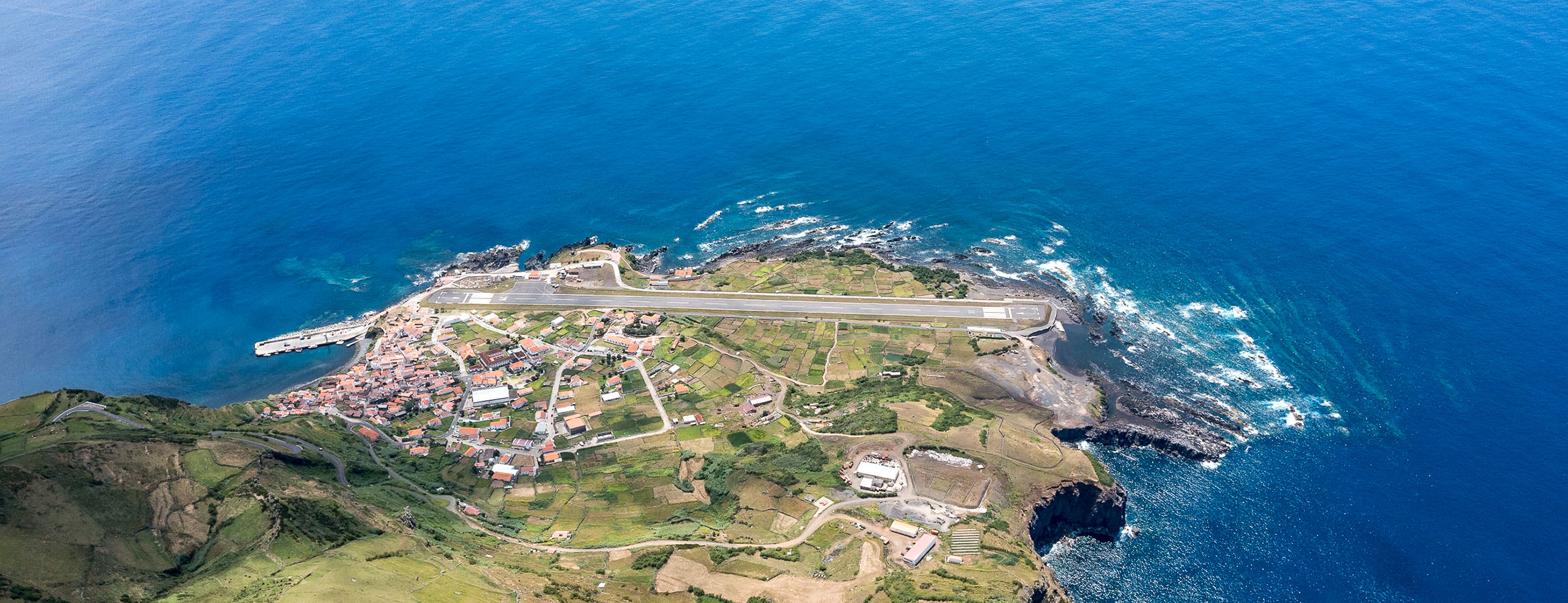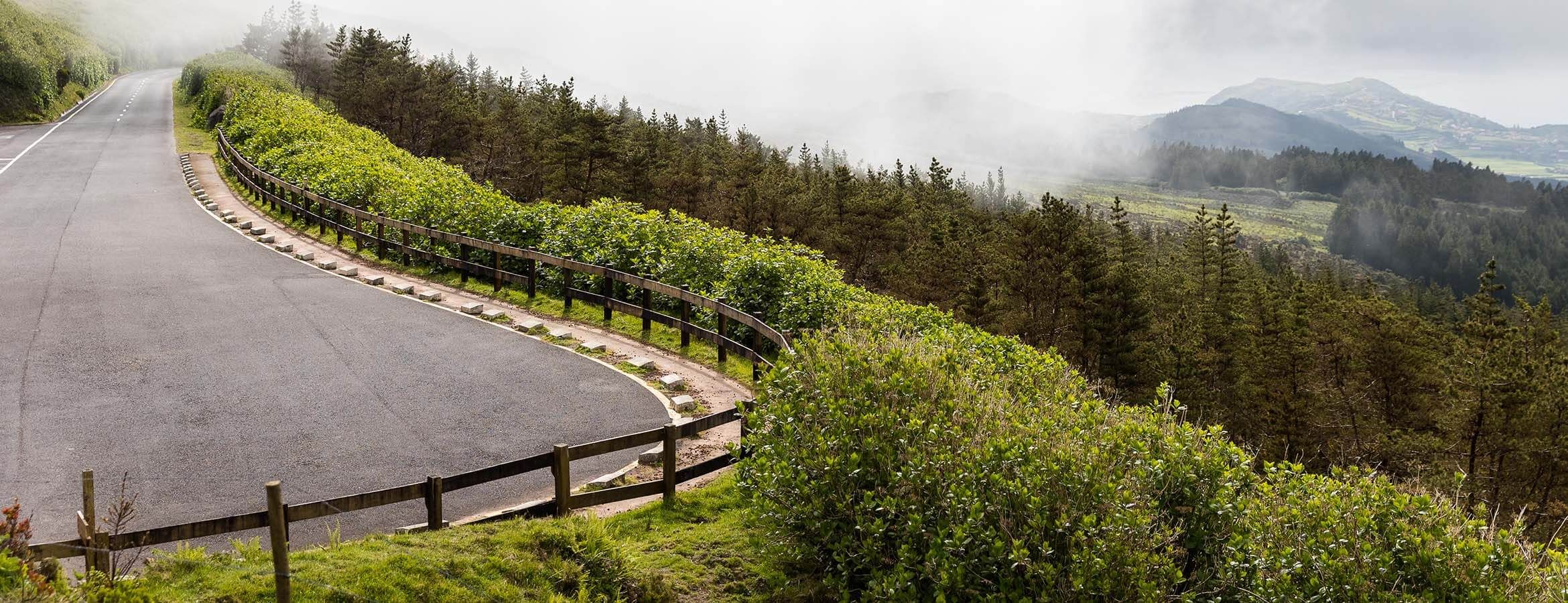

São Jorge
With a length of 54 km and a maximum width of 6.9 km, São Jorge Island features a long volcanic ridge stretching from northwest to southeast.
With a length of 54 km and a maximum width of 6.9 km, São Jorge Island features a long volcanic ridge stretching from northwest to southeast. The area of the island reaches 243.9 sq. km, and it is the home to 9.171 inhabitants (2011 data). The island of São Jorge is part of the Central Group and is one of the corners of the so-called "triangle islands" together with Faial and Pico, the latter of which is 18.5 km away. At an altitude of 1,053 m, Pico da Esperança is the highest point of the island and is located at 38°39'02'' north latitude and 28°04'27'' west longitude.
Given its proximity to Terceira, it is believed that the Portuguese navigators discovered São Jorge Island along with the other islands that surround it. As the second island to be inhabited in the Central Group, it is believed that it started to be populated around 1460. A decade later, several settlements were already established on the western and southern coasts, including in Velas. The arrival of the Flemish noble Wilhelm Van der Haegen marks the foundation of the Topo community in the east end of the island.
In 1483, the captaincy of São Jorge Island, which was developing rapidly, was given to João Vaz Corte Real, who was at the time the captain of Angra do Heroísmo on Terceira Island. A town charter was awarded to Velas at the end of 15th century, a status that was also extended to Topo in 1510 and to Calheta in 1534. The prosperity of the island came from wheat, but from early on the island also stood out for the quality of its pastures.
Left to a certain isolation due to the lack of safe ports, São Jorge Island progressively lost its economic influence. In the 16th and 17th centuries, the island was visited by the unwelcome English and French privateers, as well as by the ruthless Turkish and Algerian pirates. The Du-Gray-Trouin incursion in Velas in 1708 became famous. Defeated by the people’s heroic resistance, the French corsair left São Jorge Island with many casualties in his crew.
From the 16th to the 19th centuries, the inhabitants’ lives were hit by agricultural crisis, which caused food scarcity, and by earthquakes and volcanic eruptions, which caused great destruction. Similarly to other islands, the economy was based on agriculture and cattle breeding, namely on wheat and vineyards, on the extraction of orchil, and on livestock that from early on generated important secondary sectors linked to cheese and wool. The fishing industry became important between the end of the 19th and the 20th century, first through whaling, and since the 1960s, through the fishing of tuna. Currently, the excellent quality of the pastures of São Jorge has become evident in the production of the island’s typical cheese made from raw cow’s milk. São Jorge Cheese is a protected designation of origin, and the island is a demarcated region for its production. The island’s airport and the modern ports of Velas and Calheta have contributed to the full integration of São Jorge Island into the Azores Archipelago and into the world.
The elongated shape of São Jorge Island and the rhythmic sequence of cones that characterise its central part appear on the horizon as the wavy back of a prehistoric animal fast asleep. The plateau of the inner part of the island, where the volcanic cones that generated the island were born, gives way to high, steep cliffs that either come to an end in the deep blue sea or in small flat areas at sea level, the famous fajãs of São Jorge.
The green of the woods and of the semi-natural pastures, the brown farmland, the black rocky headlands, and the blue sea complete the palette of colours and shades. The presence of countless dragon trees and fragments of endemic vegetation in enclosed valleys protected from the action of man are some of the hallmarks of this island.
The association to brown seems to lie in the colours of the rock at the Rosais Headland. But it also could come from the dark tones of the cones of the central ridge. One has to understand the nature of the island while travelling through territory of repeated climbs and descents.
The fajãs, a designation equally used in the Macaronesian archipelagos of Madeira and Cape Verde, are the most iconic element of the island’s landscape. Flattened surfaces formed near the sea and framed by more or less imposing cliffs, the fajãs resulted either from lava flows that entered the sea (such as Fajã dos Bodes e de São João) or from the detachment of land and rocks from the cliffs (as is the case of Fajã dos Vimes) due to earthquakes, heavy rain or some other instability that affected the cliffs.
Fertile soils, a shield against the strong winds and fog that affect the higher central part of the island, and their favourable weather attracted the settlers for the permanent farming of these small plains, despite the difficult access to some of them. Beans, bananas, taro root, coffee, potatoes, oranges, everything seems to thrive in these areas, where the mighty dragon tree is not ashamed of growing. Over the years, the increasing demands of modernity and their vulnerability to the whims of nature led residents to abandon several fajãs, but many are still inhabited all year round or only at certain times of the year associated with agricultural activities and festivities.
The more than 70 fajãs of the island of São Jorge symbolise the natural beauty and isolation that have dominated the history of the island and offer extraordinary and unique panoramic views which are best enjoyed from the island’s network of trails. From the detrital fajãs of Cubres and Caldeira de Santo Cristo, with their coastal lagoons, to the lava fajãs of Velas, Almas and Ouvidor, there is a wide range of places to enjoy.
The volcanic nature of the island can be seen by roaming the roads and paths that meander through the central volcanic ridge of São Jorge, where two hundred small cones display their once active craters which are now gently occupied by small lakes, temporary ponds or bog areas. The peaks of Velha, Esperança and Areeiro have lookouts marked with signs that provide dazzling views over the coastline. When one raises the eyes, one finds the contour of Faial, Pico and Graciosa so far away and, at the same time, so close.
Crossing its bumpy inland is an invitation to get to known and enjoy the nature of São Jorge, where the craters of Bocas do Fogo (Mouths of Fire), active in 1808, are followed by a succession of semi-natural and natural pastures used by rabbits and common buzzards as a habitat. Bunches of hydrangeas enclose pastures and patches of Japanese cedar and Azores heather frame the island’s vegetation.
In addition to its typical fajãs, the coastline of the island is characterised by the towering Rosais Headland, facing Faial, and the Topo Headland and Islet on the eastern side, which enhance the natural beauty of São Jorge and afford superb views over the ocean.
The island's coastline includes rocky and jagged tips that penetrate the sea, small and sheltered inlets, several-hundred-metre-high cliffs dropping almost vertically into the sea, and even submarine volcanic cones eroded by the sea, as is the case of Morro de Lemos and Morro de Velas.
Despite the relatively small area of the island, the extensive coastline which results from the elongated shape of São Jorge provides a vast mosaic of scenic places and framings, where visitors can look for the best angle for a special shot, taking advantage of the colour of the rocks, of the shades of the endemic and natural vegetation and of the grace of a sea bird at rest or in flight.
While passing by Urzelina, one’s eyes are drawn to an isolated church tower in the middle of the landscape almost entirely surrounded by black rocks. The only trace left of the original construction, which was buried by the ruthless volcanic eruption of 1808, witnesses the struggle and the resilience of the Azoreans in face of natural adversities.
In Calheta and Topo, one can see picturesque ports that are the gateway to centuries-old homes and churches with stories to tell. In Velas, the Portão do Mar (Sea Gate) has welcomed since 1799 the boat travellers that have arrived at the port. Within the town, every step leads to valuable buildings, such as the São Jorge Mother Church and the Town Hall. The Baroque church of Santa Bárbara (18th century) is a fascinating example of religious architecture. This church is located in Manadas. Its black and white façade hides an interior with a cedar roof, golden engraved altar and walls, tile panels, altarpieces and paints.
Although the production of pottery has virtuThe ponto alto bedspread continues to be handmade in wood weavers’ loom. Few craftswomen are active nowadays, but some may still be found working in Fajã dos Vimes. The Ribeira do Nabo Handicrafts Cooperative also works as a display for the well-known mantas de São Jorge (São Jorge blankets), as well as for cloths, towels, rugs, among other items.
ally come to an end on the island, other works are still done on manual weaver's loom, supported by the local handicraft cooperative (Cooperativa de Artesanato de Santa Maria). Table cloths, flax shirts, bedspreads and wool jerseys are some of the pieces that are made by local artisans.
While Velas hosts the Sacred Art Museum, next to its Mother Church, the São Jorge Island Museum in Calheta exhibits ethnographical collections of pottery, weaving, agriculture, cattle-raising, furniture and photography. Comprising the 19th and 20th centuries, this space functions as an illustration of Francisco de Lacerda’s time. Born in Ribeira Seca, in 1869, this “European from São Jorge Island” achieved a brilliant international carrier as an orchestra conductor. Remarkable musicologist, Francisco de Lacerda carried out an important inventory of the island’s folklore. From the work of this composer, Trovas stands out. It is a set of plays for singing and for piano based on the Portuguese and Azorean folk music.
The festivity in honour of the saint after which the island is named (St. George) takes place on 23 April. In the municipality of Velas, the celebrations include a procession, musical shows and exhibitions.
The Semana Cultural das Velas (Velas Cultural Week) enlivens São Jorge Island, as well as the other “triangle islands,” during the month of July. Its programme comprises lectures, conferences, a book fair, nautical events, musical shows, a cuisine fair, in short, appealing events for every taste, turning Velas into a quite lively place. In the same month of July, Calheta suggests the Festival de Julho (July Festival), a festival full of ethnographical parades, popular music, sports events and exhibitions.
The processions that occur in several fajãs embody the religious devotion, holding hands with folk festivities where popular songs are played in the traditional guitar called viola da terra.
The Holy Ghost festivals mobilise people from the island and from the outside and take place between May and September as in the other islands.
Internationally famous and with a so-called insurmountable taste, the São Jorge Island Cheese is probably the most well-known food product of the Azores. The União de Cooperativas Agrícolas e Lacticínios de São Jorge in the parish of Beira works as a plant for the aging, classification and certification processes of the cheese produced all over the island. The Protected Designation of Origin is only awarded to the specimens that follow the traditional ingredients and methods. It is believed that the production of cow’s milk cheese goes back to the Flemish that populated Topo. The São Jorge Island Cheese is hard/semi-hard and has a slightly peppery aftertaste. It is round-shaped and weights from 7 to 12 kg, being cut in wedges.
Spontaneously born and raised in the lagoon of the Caldeira de Santo Cristo Nature Reserve and Special Ecological Area, the clams are another exclusive food wonder of São Jorge Island. The lagoon of this fajã is the only place in the Azores where there are clams, which stand out for their size, flavour and meaty texture. The harvest of clams is limited and this delicacy can only be enjoyed in some restaurants.
The microclimate of some fajãs enabled the growing of some rarities, such as the coffee tree, a rare case in Europe. In Fajã dos Vimes one can enjoy coffee of intense taste and aroma, made out of locally collected grains. Just as the coffee, the cinnamon aguardente is good to complement the taste of the island’s pastry, of which coscorões, rosquilhas and curd cakes are part of the traditional recipes. The espécie, a horseshoe-shaped pastry with “windows” through which one can peek at its filling, is another typical pastry of the island. There are several versions of this recipe, but the use of spices, such as anise, cinnamon and pepper, is common to every one of them.














